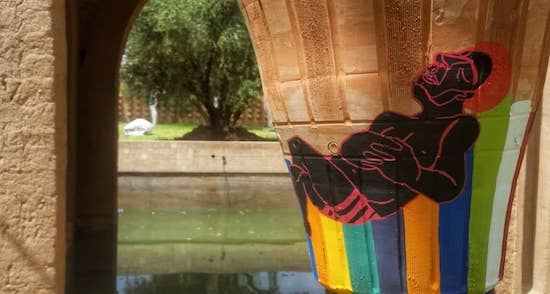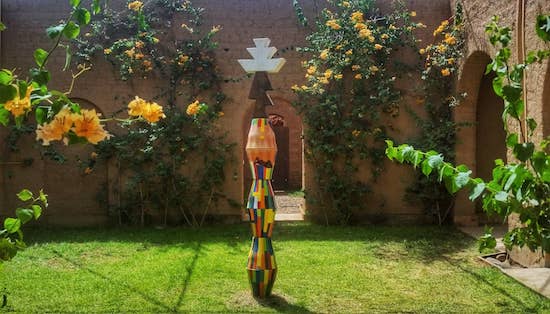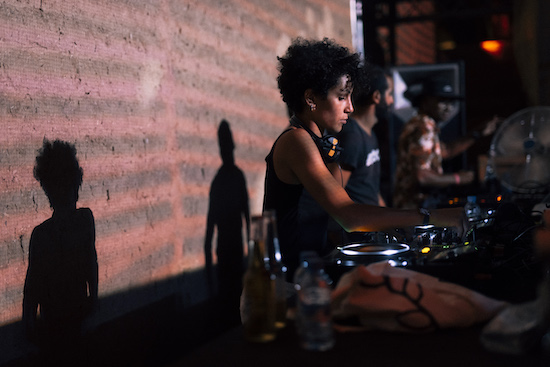Deena Abdelwahed photograph by Tim Buiting
Rainy season in Marrakech is usually between November and January. Atlas Electronic festival runs from August 30 to September 3. With daily forecasts of around 39°C for the weekend, rain seemed unlikely.
But there is a suggestion from the start of the festival that one of the artworks on display could alter the usual forecast. The Freedom Column installation – by Hosein Jaddad and Klara Debeljak – towers over the site. The sculpture is based on the Moroccan Taghonja: a dress-like totem used for summoning rain.
Atlas Electronic festival is held in Villa Janna, an ecolodge on the outskirts of Marrakech. There are four stages at Villa Janna: the main space which is a crumbling, carpeted amphitheatre set deep into the ground. The second stage is set on a boardwalk by a swimming pool. It is paradise. I later find out ‘Villa Janna’ translates as ‘Gateway to Heaven’.
On arrival I find a quiet area of shade away from the sun in a tent where members of Saharan desert blues group Génération Taragalte are playing, with festival goers either relaxing on cushions, or joining in on percussion using calabash drums.
Over four days the festival includes phenomenal sets by Jamie xx (who kicks proceedings off with a tribute to Aretha Franklin), Lena Willikens, a six-hour Hessle Audio session (with Ben UFO, Pangaea and Pearson Sound), Zozo, The Pilotwings, Tash LC and Awesome Tapes From Africa, to name but a few.
During a live set of darkly experimental music Deena Abdelwahed fuses samples of traditional music with avant-garde futurist soundscapes evolving into organic trance patterns. It is brooding and menacing, and thoroughly enjoyable.
A bright silhouette of the moon is projected on the wall behind the stage during the performance of Génération Taragalte, whose sounds recreate the expansive, lonely atmosphere of the desert. As the group play members of the crowd dance arm in arm, in harmony with the rich, unfolding layers of the music.
As the sun sets on Saturday, winds start blowing up clouds of sand across the site, and the heavens open at Villa Janna. For two hours there is rain over Marrakech causing crowds to seek refuge in tents. I worry the Taghonja – the rain-summoning sculpture – will be struck by lightning, but eventually it is left unharmed. There is something about rain on a swimming pool, and there is something about rain in the desert, too.

The Freedom Column photograph by Hosein Jaddad
I speak to one of the artists, Hosein Jaddad, after the festival about the sculpture and the rain.
The artwork was a collaboration with Slovenian artist Klara Debeljak. How did you approach your creation so that it could be open to interpretation and represent unity between artists from different cultures?
Hosein Jaddad: Achmed Belksami, the organiser of the art village of Atlas Electronic, sent me an email introducing an artist from Slovenia who wanted to collaborate with me. So he brought us together and got us talking about the artwork and to decide what we would do.
The first time I saw Klara’s artworks, how she worked and the colours and the shapes that she painted, I liked the way she created colours and drew characters from her imagination. I told her about my idea for the sculpture and she agreed and was very open to work with and very flexible. Also, the concept of the sculpture is about freedom, so I just told her that she had freedom. The main concept is freedom, so we have to be really free to draw anything in your head.
After we met at Villa Janna we went to buy the paints and brushes and were talking like normal people having fun at the festival. As she started to paint, to put the colours on the totem, she really gave it another spirit, full of colours and characters laying down and enjoying their times there. It was a really good experience to work with her and especially her soul. I thought at first, it’s like a child inside her, drawing on my sculptures and it was fun, just to watch her painting the totem.
It also gave me a feeling about the concept of the sculpture. The freedoms. We really had freedom to do this artwork and to be together and it reflected our idea.
What did The Freedom Column represent, and how did the end result compare to your original vision?
HJ: It is about freedom, about aspiration, about tolerance, about love, peace. So my vision represents humanity and positive thinking of life. And my vision is still the same, because I was free to make it. I didn’t have any pressure or anything to think about. I just made it. That’s why I called it freedom. Because it was made with freedom, with free hands, free soul, free spirit.
So my vision before and after is still the same as I focused on being free and to own my artwork. I represent freedom. I really wanted all the people at the festival to come and draw on it and get involved, but we didn’t arrange to do that because it was really it was not a good time to do it and organise for it. It’s just about freedom and it’s made with love and freedom. That’s all.

There was a suggestion that the column could bring the rain – what was the thinking behind this?
HJ: When I was first making the shapes of the sculpture I was really influenced by Moroccan architecture. When I went to the Medina and started to look at the houses and the shapes of the architecture I got inspired a lot by the shapes. At first I wanted to call the sculpture Taghonja.
The story behind the Taghonja is that in the past there was a Moroccan tradition where people would take to the streets together protesting, asking for rain from the heavens. So they held a sculpture, which is like a djellaba, or dress, and hung it on a big oud stick and started walking in the streets, asking for rain. It came to my mind that in those days we really needed something, not only rain. We needed something to come to save us, as humans. So I thought about that.
When I made the installation in Villa Janna I started to talk to people and while it was just for fun, I didn’t believe in that, it really happened. It was so crazy.
“Have I told you that there is a tradition in Morocco that they make sculptures to bring the rains?” It was just fun and it’s a symbol that all of us can make it rain someday if we want. It’s not about the sculpture, or about something to call something. It’s just the human will.
And this sculpture made the rain that day. Before the festival I was talking with a traditional Moroccan man working in the garden there and I asked him, “What do you see in this sculpture?” And he asked me, “What is this sculpture?” I told him, “It’s Taghonja.” “Oh,” he replied. “So it’s the totem that Moroccans make to bring the rain.” I told him, “Yeah.” And we started to laugh about it. But next day, we had the rain. And I was so surprised, “Woah. What’s happening? It’s raining now. It’s really worked.” You could make anything and if people still do not accept it, if it happens they believe you and will follow you.
I think it’s the same concept that works in the past, in history. People accepting something, or making something, and when it happens, people believe it and are shocked and try to make it true, with belief. It’s just about thinking, human thinking, you know? It has nothing to do with nature, or anything. It’s just what we want to put in our mind and what we don’t want. It’s all about thinking about how we see things, how we explain it. That’s why we are still fighting each other, just because we think different.


